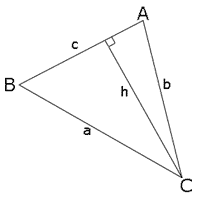Law of sines
In trigonometry, the law of sines (or sine law) is a statement about arbitrary triangles in the plane. If the sides of the triangle are a, b and c and the angles opposite those sides are A, B and C, then the law of sines states:
where R is the radius of the triangle's circumcircle. This formula is useful to compute the remaining sides of a triangle if two angles and a side are known, a common problem in the technique of triangulation. It can also be used when two sides and one of the non-enclosed angles are known; in this case, the formula may give two possible values for the enclosed angle. When this happens, often only one result will cause all angles to be less than 180°; in other cases, there are two valid solutions to the triangle (see the ambiguous case section of this article for further information).
It can be shown that:
where s is the semi-perimeter,
Derivation
Make a triangle with the sides a, b, and c, and angles A, B, and C. Draw a line from the angle C to the side across c so that it divides the original triangle into two right angle triangles. Mark the length of this line h.
It can be observed that:
- and
Therefore:
and
Doing the same thing with the line drawn between angle A and side a will yield:
Full proof:
Make a triangle ABC with sides a, b, c and the γ angle at C. Make an axis through the center of b and another through the c side. Mark the point of intersection of the axis S. Draw a circle k with its center in S with the radius r = |SA| = |SB| = |SC| (the Circumcircle). Through the medial angle law, the angle at S is 2*γ.
Thus, it can be observed that:
or:
and then
Applying cyclic permutation:
- (č.b.t.d)
Examples
Here is an example of how to solve a problem using the law of sines:
Given: side a = 10, side c = 7, and angle C = 30 degrees
Using the law of sines, we know that :
Plugging in the given values, we find that :
Simplifying, the sine of angle A is equal to 5/7, or approximately 0.714. Thus, angle A is equal to 45.58 degrees.
Or another example of how to solve a problem using the law of sines:
If two sides of the triangle are equal to R and the length of the third side, the chord, is given as 100' (30.48 m) and the angle C opposite to the chord is given in degrees, then angle A = angle B = : and
- or
- or
This is North American railroad surveying practice.




















